Dell U2412M - 16:10 IPS without Breaking the Bank
by Chris Heinonen on February 28, 2012 9:00 AM ESTDell U2412M Color Quality
With that long write-up out of the way, you might expect that there was something in particular to the U2412M that led me to explain our testing and results. There initially was but it actually proved to be a software issue; still, I thought the explanation on the previous page would be useful for everyone. For our uncalibrated measurements, I used the profile included on the CD, set the brightness to 200 nits, and then measured using the i1Pro meter.
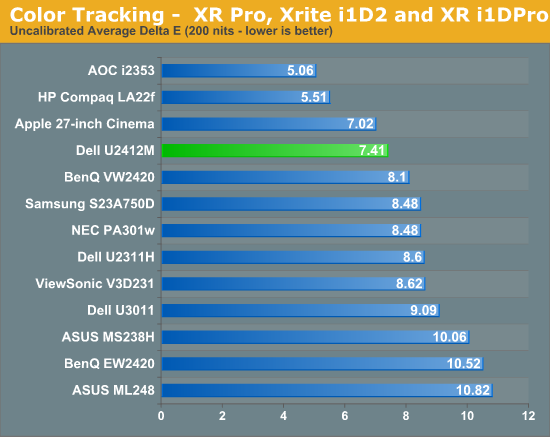
Here we see a score over 7, which is about what we expect to see on a monitor straight out of the box. Comparing this to previous displays isn’t easy to do as most of those used the i1Display2, which isn’t nearly as accurate as the i1Pro is. Of course, all displays do better once calibrated, so I kept the brightness target at 200 nits, with a white point target of D65, gamma of 2.2, and minimum black target.
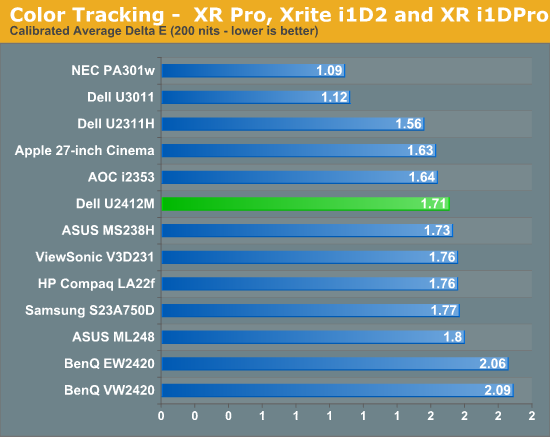
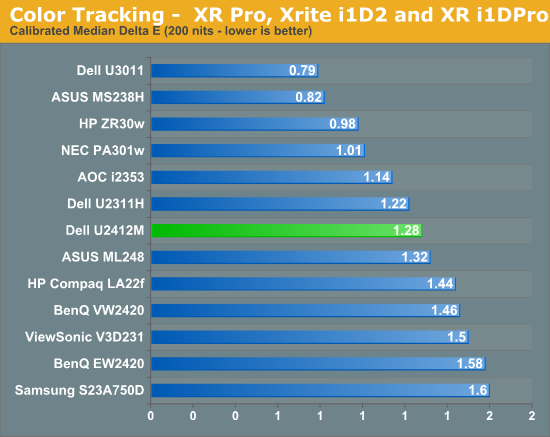
The errors for the Dell look very similar to what we have seen on other monitors. The color gamut is not AdobeRGB, so some of the patches are outside of the range for the display and can’t be rendered correctly. This leads to the spikes in the chart for blue samples and the higher average dE. We included the median dE number so you can see that the value drops quite a bit if we look at that. Everything other than blue is pretty good, and the grayscale is right around 1. So this is nice overall, though not perfectly accurate due to the color gamut and possibly due to the 6-bit panel. Now we will profile again to see if the results are similar with a target of 100 nits instead of 200 nits.
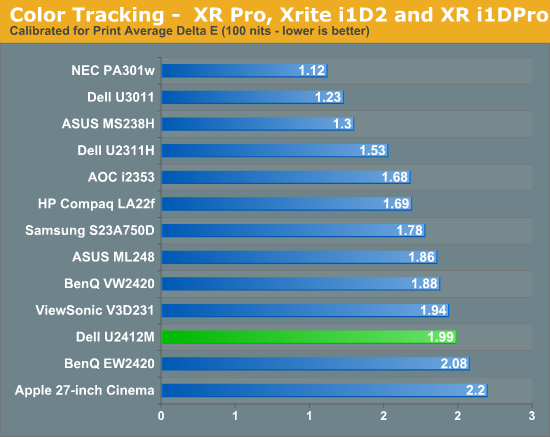
The error seems to rise a bit here, most notably in the grayscale that you would want to keep very neutral for print work. Most colors stay below 3.0 in their error (which is considered the threshold of being visible to the naked eye in motion) but again the blues are past that and errors would be visible to someone that was looking. For serious print work, you probably need to look for something that can use the full AdobeRGB gamut.



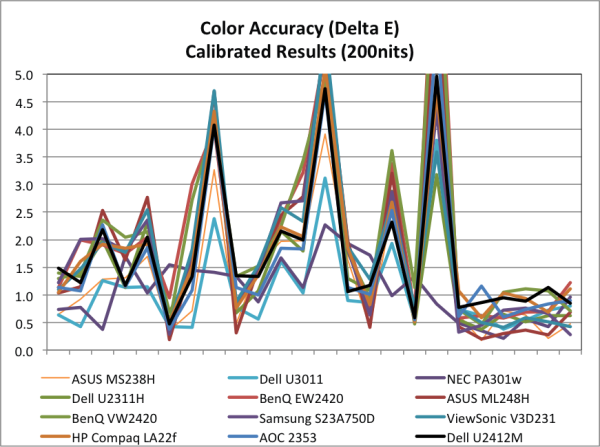
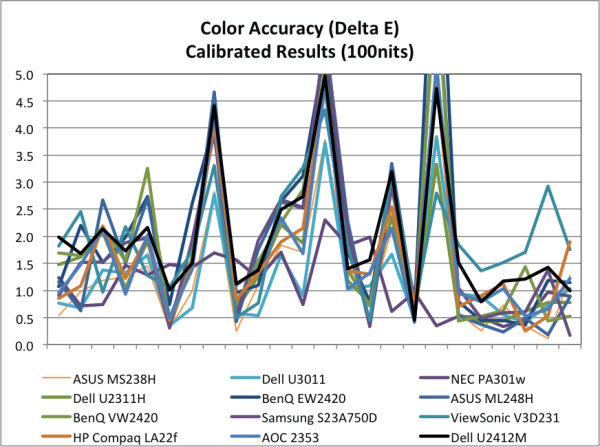








143 Comments
View All Comments
DarkUltra - Tuesday, February 28, 2012 - link
Maybe not $15k, but there are enthusiasts out there willing to buy sandy bridge E, high end motherboards and gtx 580 tri-sli setups. So why not a 24" 1920x1200 120Hz IPS with zero input lag?But I do agree a 30" IPS might be too expensive - until theres more demand that is. So please enlighten your next.
rscoot - Tuesday, February 28, 2012 - link
I'm not even sure if the technology exists to have zero lag 120Hz IPS displays, but when one requests the monitor equivalent of a Bugatti Veryon, one has to expect to pay the equivalent price. The economy of scale just isn't there otherwise.IceDread - Wednesday, February 29, 2012 - link
I'd pay 15k for "120Hz, 30", IPS @ 16:10, 2560:1600, no input lag", no doubt.mtoma - Wednesday, February 29, 2012 - link
I think perhaps an OLED display is bettter suited for in-door use. We don't need that much brightness, but better contrast we do. Also, why we don't see integrated webcams more often? Why a smartphone needs to have all the goodies (picture and movie recording in 720p or 1080p, Gorilla Glass, OLED).Regarding to 120 Hz (or even higher), that feature is only good when it can be disabled. Surely it's useful in games, but under no circumstances in movies. Really!
AnnonymousCoward - Saturday, March 3, 2012 - link
> Does anyone know how far from my dream we are?Very, very far. It has been 6 years since the 3007WFP came out, and nothing has superseded it. I would sure love something that steps it up: 120Hz, 2560x1600, 32", <17ms lag.
Sergio526 - Tuesday, February 28, 2012 - link
Not an extra 120 pixels, but 230,400 pixels you gain over a 1920x1080 monitor, but who's counting?Sabresiberian - Tuesday, February 28, 2012 - link
Hehe, good way to point out how much difference there really is between 16:10 and 16:9.;)
seapeople - Wednesday, February 29, 2012 - link
Or.... about 11% more pixels. For 50% more money.I swear, the math abilities of today's teenagers is going downhill fast.
colonelclaw - Tuesday, February 28, 2012 - link
Thanks for a very interesting read. As soon as this monitor was announced I was looking forward to see how it compared to other IPS monitors, and that's exactly what you did. It's exactly the kind of display I would like to fill my office with - good quality at a low price.Would you say that the NEC is the absolute best a monitor can get these days? Or is there something even better (and probably more expensive) from Eizo? I'm always interested to know what the reality is between the best and worst of any one product type, and whether or not the expense is worth it.
Oxford Guy - Tuesday, February 28, 2012 - link
"Would you say that the NEC is the absolute best a monitor can get these days? Or is there something even better (and probably more expensive) from Eizo?"Best depends on your usage model. That includes what you plan to do with it, how big your budget is, and what space you plan to use it in (lighting).
There's an HP Dreamcolor monitor with RGB LED backlighting. That's pretty interesting for color pros. But, it's not perfect.
There's another HP (27") with a constant control backlight -- which avoids PWM flicker. But, it's not perfect either. It has no onscreen display and has a very fine pixel pitch which is tough for old eyes.
Eizo makes some nice monitors, but they can be pricey.
I got a BenQ EW2420 refurb and it works fine for my usage, although I really wish it would have a constant control backlight. Flicker does fatigue my eyes after a while.